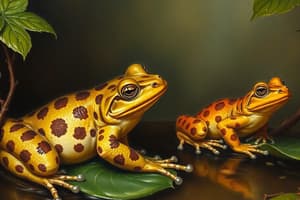Podcast
Questions and Answers
Which environment is not typically inhabited by frogs?
Which environment is not typically inhabited by frogs?
- Tropical rainforests
- Freshwater bodies
- High mountain peaks (correct)
- Grasslands
Where are frogs most diverse in terms of species distribution?
Where are frogs most diverse in terms of species distribution?
- Urban areas
- Temperate forests
- Deserts
- Tropical regions (correct)
What is a significant threat to frog species according to conservation status?
What is a significant threat to frog species according to conservation status?
- Non-native species introduction
- Excessive breeding
- Habitat destruction (correct)
- Overpopulation of frogs
Which frog family is known for tree-dwelling species?
Which frog family is known for tree-dwelling species?
What reproductive strategy involves frogs hatching into miniature adults?
What reproductive strategy involves frogs hatching into miniature adults?
Which factor does not contribute to the declining populations of frog species?
Which factor does not contribute to the declining populations of frog species?
How do male frogs typically attract females during the breeding season?
How do male frogs typically attract females during the breeding season?
Which environmental feature is essential for frog hydration and reproduction?
Which environmental feature is essential for frog hydration and reproduction?
Which statement about frog species is correct?
Which statement about frog species is correct?
What type of parental care behavior do some frog species exhibit?
What type of parental care behavior do some frog species exhibit?
Flashcards are hidden until you start studying
Study Notes
Habitat Diversity
- Frogs inhabit a range of environments, including:
- Tropical rainforests
- Temperate forests
- Grasslands
- Deserts
- Freshwater bodies (ponds, lakes, rivers)
- They require moist environments for hydration and reproduction.
- Some species can adapt to urban areas and are found in gardens and parks.
Global Species Distribution
- Approximately 7,000 species of frogs are recognized worldwide.
- Distribution includes:
- Most diverse in tropical regions (e.g., Central and South America, Southeast Asia).
- Present on every continent except Antarctica.
- Notable families include:
- Hylidae (tree frogs)
- Ranidae (true frogs)
- Bufonidae (toads)
Conservation Status
- Many frog species are threatened or endangered due to:
- Habitat destruction (deforestation, wetland drainage).
- Climate change (temperature shifts, altered precipitation patterns).
- Pollution (pesticides, heavy metals in water bodies).
- Disease (chytridiomycosis caused by the chytrid fungus).
- The International Union for Conservation of Nature (IUCN) Red List categorizes many species as vulnerable or endangered.
Breeding Behaviors
- Frogs exhibit diverse reproductive strategies:
- Most are amphibious, laying eggs in water.
- Some species have unique adaptations, such as:
- Direct development (hatching into miniature adults).
- Terrestrial or arboreal egg-laying.
- Males often call to attract females; calls can vary significantly across species.
- Parental care behaviors vary, with some species guarding eggs or transporting tadpoles to water.
Habitat Diversity
- Frogs thrive in various environments: tropical rainforests, temperate forests, grasslands, deserts, and freshwater habitats such as ponds, lakes, and rivers.
- Moist environments are essential for frogs for hydration and reproductive processes, leading to their preference for wet habitats.
- Some frog species have adapted to urban areas, allowing them to be found in gardens and parks.
Global Species Distribution
- Globally, there are around 7,000 recognized species of frogs.
- The greatest diversity of frog species occurs in tropical regions, particularly in Central and South America, and Southeast Asia.
- Frogs are present on all continents except Antarctica, showcasing their wide adaptability.
- Notable frog families include:
- Hylidae (tree frogs)
- Ranidae (true frogs)
- Bufonidae (toads)
Conservation Status
- Many frog species face threats or are endangered due to:
- Habitat destruction from activities such as deforestation and wetland drainage.
- Climate change impacting temperature and precipitation patterns, affecting frog habitats.
- Pollution resulting from pesticides and heavy metals contaminating water bodies.
- Disease, particularly chytridiomycosis, which is caused by the chytrid fungus and greatly impacts frog populations.
- The IUCN Red List categorizes numerous frog species as vulnerable or endangered, highlighting the urgency of conservation efforts.
Breeding Behaviors
- Frogs demonstrate a variety of reproductive strategies, primarily laying eggs in aquatic environments due to their amphibious nature.
- Some frog species have evolved unique reproductive adaptations:
- Direct development allows eggs to hatch into juvenile forms resembling miniature adults.
- Different strategies for egg-laying include terrestrial (on land) or arboreal (in trees) methods.
- Male frogs often use vocal calls to attract females, with variations in calls being significant across different species.
- Parental care practices vary widely; some species protect eggs or transport their tadpoles back to water for survival.
Studying That Suits You
Use AI to generate personalized quizzes and flashcards to suit your learning preferences.




